

The Military Museum of the Chinese People's Revolution (official site, see also Wikipedia) in central Beijing has a Ryan Firebee recce drone. It is displayed next to a Nationalist China operated U-2. Both are claimed to have been shot down. Alternative names of the museum are 'Peoples Republic of China Military Museum' and 'Military Museum of the People Liberation Army'.
Only a few photos have surfaced so far. Mark Haswell photographed the U-2 wreck, and parts of the Firebee could be seen in the background. These parts are shown here. Limited information can be gained from the partial views. The wings appear to be tapered, which excludes the many versions with constant-chord wings.

|

|
Norman Graf visited the museum in 2007, and kindly provided the photos he made of the Firebee on display. The airframe is quite deformed, with the engine nacelle completely missing. Because the small wing fences are absent, it could be that the wing is positioned upside-down. Interestingly the yellowish parachute riser can be seen still attached to the forward end of the spine. The Firebee is clearly painted black, but appears to covered with a thick layer of dust on the top surfaces. Chinese student Qiushi Zhu kindly translated the sign.
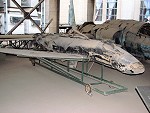
|
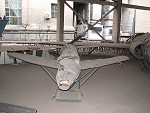
|

|
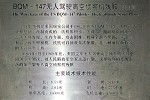
|
|
The aircraft is made in 1962 by Ryan company, USA, which is based on and derived from the old BQM-34A 'Firebee'. The volume of the aircraft is quite small, but able to fly at high altitude. The radar reflection of the aircraft is very weak, which means it is relatively hard to be detected by radar. The survival rate over missions is quite high due to the fact that the aircraft is very difficult to get attacked. The body of the aircraft is painted in black and the camera is located at the nose. Since the aircraft can be reused multiple times, the cost is relatively cheaper. In general, the aircraft is very efficient economically. From August 1964 to the end of 1969, there are 17 unmanned surveillance aircrafts from USA shot down by PLA (Chinese Army) when they invade the Chinese air-zone. The exhibition here is the third one shot down during that period. The properties of the aircraft
|
Haydn Neal visited the museum in 2010, and kindly provided the photo below. A notable change in the display is that the vertical tail is now absent. The first detail view shows the nose section. On later models this was made of glass fiber, but here the edges don't show typical sharp and ragged edges and delaminations of fractured composites. The fractured wing skin looks fairly thick and parts overlap in a strange way. The rear fuselage part show the fuel tank plug on the right, a badly twisted avionics bay in the middle (suggesting a big impact load on one of the tailplanes), followed by the main parachute cone (which evidently was never deployed) and the parachute riser fairing with the riser partially inside.

|

|

|

|
Airliners.net has more photos of the U-2 in which the Firebee is partially visible, see the photos by Ed Groenendijk, Yu Ming, and Li Jing.
In 2019, the airframe remains were seen resting on a new frame, and in a different location in the museum, see NTG842's photo on Flickr. The wing still is upside-down.
In 2020, I came across a webpage about Ballistic, cruise and anti-aircraft missiles in the exposition of the Military Museum of the Chinese Revolution. It shows two different views of the 'new' display. It's still difficult to analyze the battered remains, for example the whole nacelle is missing. But we can now clearly see how badly the rear fuselage is twisted. This also resulted in one of horizontal tailplanes now acting as the vertical tailplane. I find the supposed horizontal tailplanes looking a bit strange, just maybe they were sourced elsewhere.
'Lightning Bugs and other reconnaissance drones', pages 74 to 79 plus 98 and 116 tell us more about the Chinese missions and the Firebees shot down.
On page 98 it is stated that the operational flights started on 20 August 1964. The caption of the photo shown on page 78 claims to show the first 147B to be shot down over China. The date was 15 November 1964, and it was put on display 2 April 1965 in Beijing. On page 74 more details are reported: it was 147B #19 (B-19), and it was attacked by 16 to 20 fighters, possibly even a planned effort to get it shot down in order to obtain electronic intelligence.
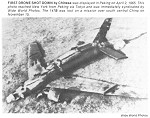
|
The photo shown on page 79 has an amazingly detailed caption (good intelligence!). The 147B in the foreground is said to have been shot down on 3 April 1965, the one in the middle on 31 March 1965, and the one in the back on 2 January 1965. The photo caption on page 116 identifies the front one as B-23 'Crazy Legs', and the text on page 78 reveals that the middle one was B-20 and the one in the back B-21.
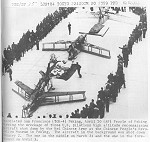
|
If the museum's sign is correct that it was the third 147B shot down, and if 'Lightning Bugs and other reconnaissance drones' lists all initial losses correctly , then the middle Firebee should be the one on display in Beijing, and its identity is B-20. Indeed the main parachute tailcone is present and the damage on the right wing looks similar to the damage seem on the museum aircraft.

|
The damage to the vertical tail (broken of at the root but with an undamaged fin tip) and the twisted rear fuselage gives some clues to the crash. Likely it was in an upright spin, and the inertia of the vertical tail resulting in the damage of the rear fuselage. In an inverted spin the vertical tail tip would have been damaged, so that scenario is unlikely. A spin, with its relatively low vertical speed, would also explain how this Firebee survived the impact relatively well without a parachute.